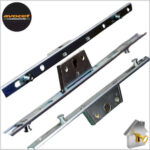 How to Do Your Own Lock Repair
How to Do Your Own Lock Repair When your locks become faulty You can attempt to fix them yourself or employ an expert locksmith. Repairing replacement window locks can be difficult and if you take the wrong route, it may cause further damage.
When your locks become faulty You can attempt to fix them yourself or employ an expert locksmith. Repairing replacement window locks can be difficult and if you take the wrong route, it may cause further damage.You must first see if the problem is caused by dust or dirt. Graphite spray or silicone-based lubricant can be used to eliminate this issue.
1. Door Handle or Knob Lock
Door knobs and handles could get loose as time passes, which could result in a jiggly door handle or knobs that are difficult to open. Loose door knobs are not only annoying but they can compromise your building's security, which is why it's important to find and resolve the issue as quickly as possible. Fortunately, a loose doorknob or handle is relatively simple to repair. Based on the type of lock system installed in your door, there are many solutions to fix it. Some lock systems have easily accessible mounting screws, while others use backplates that hide the screws. If your door is the one that is hidden, the process might be more difficult.
The majority of interior doorknobs come with a small screw known as a setscrew on the inside of the knob to prevent it from sliding over the spindle. This is part of the latch assembly. If yours is jiggly it could be due to a small screw, known as a setscrew, on the inside of the knob that prevents it from sliding across spindle. Make use of flashlights to locate the set screw and use an Allen wrench to tighten it. After the screw has been tightened by turning the knob, verify if it feels secure.
If your knob feels uneven, it could be that the set screw isn't positioned properly. To make sure the screw is positioned correctly you should look for a small, matching button on the spindle. Place the knob on the spindle after pressing the button using the flathead screwdriver. The knob should move into the proper position as you do this, which indicates that it is properly positioned on the spindle.
After ensuring that the set screw is positioned properly and tighten it once more to secure the knob or handle in the correct position. This should fix the problem If not it is, you will require removing the knob and examine the backplate for loose or missing screws. It is necessary to replace window locks the screws in this case before you can install the knob or handle. If you're not sure about this type of repair, call an expert who is skilled in repairing damaged locks.
2. The key won't spin in the lock.
There are many reasons that your key may cease to turn in the lock. One of the most frequent reasons is that the pins in the cylinder are beginning to wear out, which means they no longer have the proper shape to move the sliders, wafers, or tumblers that allow the key to open the lock. In this instance, spraying the lock with silicone-based lubricant or graphite spray will coat the pins to enable them to move.
However, if the problem is more serious and the key has been bent out of shape you might need to have it straightened professionally. A professional locksmith will use a specialty tool to straighten the keys, that is designed with an angled tip that fits into the groove that is recessed on the tip of the key. This type of tool isn't available in hardware stores, but you can purchase a kit that includes the proper tools online or at an establishment that sells locksmith tools.
A soiled or dirty lock is another possibility. As time passes, dust will accumulate in the lock cylinder, which can cause the springs and pins to seize up. In this case, you'll have spray the lock with graphite spray or a silicone-based lubricant to remove it and then reposition the pins back to their original position.
If the key itself is damaged, it could be a cause for concern. Over time, repeated use can cause wear and tear on the grooves on a key. This can lead to the key not fitting into the cylinder, therefore it is important to be aware and regularly check that your key is fitted correctly.
In the colder months double Glazing window locks replace can freeze which will prevent the pins window and door lock repair springs from moving when the key is placed. This can be a frustrating issue however it is usually solved by warming the lock up by using hot water and then changing the lubricant. However, if the lock is damaged or frozen beyond repair, it will likely require replacement window lock by a professional.
3. The lock isn't turning
If you've ever had a lock that doesn't turn and isn't able to be opened, it can be extremely frustrating. If this happens often it is advisable to consider hiring a locksmith to examine the lock to see whether they can help. This isn't always needed, as some problems can be resolved by yourself.
The key will not rotate in the lock if damaged. This could happen in the event that you've lost your key, or if it is broken inside the lock. Instead of trying to get the key from the lock, which could cause it to be further pushed into the mechanism window and door lock repair increase the risk, use needle-nosedpliers to remove the key from the lock. Be careful not to damage the lock by breaking off any part of the broken key with the pliers.
It's also possible that the lock is misaligned and this could cause the door to not latch correctly. If you're lucky enough to have an extra key, it could be tested in the lock to confirm that it is working properly and doesn't cause the cause of the problem. If you discover that the lock isn't aligned properly by tightening the screws around the strike plate will fix the issue and allow the lock to perform normally.
Another reason why your key may not be turning is because there is dirt or dust inside the lock that is hindering it from moving. Using graphite sprays or a silicone-based lubricant can solve this problem by coating the pins inside the lock to allow them to move up and down normally. It's crucial not to use oil based products like WD-40 to solve this problem, however, since they could cause more blockages later on.
It's important to know that some keys simply won't fit into all locks. If yours is one of these you might want to get a new key made at an area hardware store so that it works in the lock.
4. The Cylinder is Rotating
When a cylinder rotates in a confinement gap, it could cause hairpin vortices that can result in significant forces on the cylinder. The forces are proportional to the radius of curvature that is dimensionless x and the confinement factor k. The simplified model that is presented here predicts the effect of these parameters on the torque and force on a confined rotating cylinder. The head, tube and the main body of the cylinder are made of aluminium alloy.
If you're able to insert your key in and turn it, but the lock isn't rotating there could be an issue with the cylinder. Rekeying your lock can solve the issue. You can buy kits for this purpose on the internet or in a lot of big box stores.